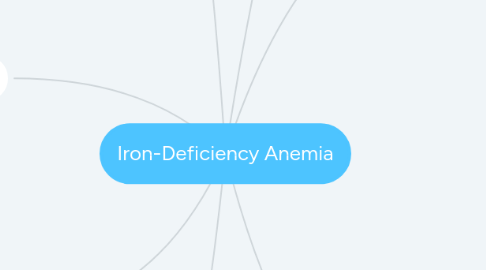
1. Causative Factors
1.1. Inadequate dietary intake
1.1.1. Eating disorders like pica (eating non-nutritional substances)
1.1.2. Vegetarian or vegan diet
1.1.3. High-calcium diet can impair iron absorption
1.2. Impaired absorption
1.2.1. Celiac disease
1.2.2. Atrophic gastritis
1.2.3. Helicobacter pylori infection
1.2.4. Bariatric surgery
1.3. Increased requirement
1.4. Excessive blood loss
1.4.1. Menorrhagia (excessive menstrual bleeding)
1.4.2. Medications that can cause gastrointestinal bleeding (like nonsteroidal antiinflammatory drugs (NSAIDs))
1.4.3. Pregnancy and delivery
1.4.4. Frequent blood donation
1.5. Parasite infestation
1.6. Surgical procedures that decrease stomach acidity, intestinal transit time, absorption (i.e., gastric bypass)
2. Risk Factors
2.1. Having a low iron diet (i.e., vegetarianism or veganism)
2.2. Females during reproductive years
2.3. Gastrointestinal disease that impairs absorption of iron
3. Diagnostics
3.1. Labs
3.1.1. Decreased hemoglobin and hematocrit
3.1.2. Decreased serum iron and ferritin (<30 ng/mL)
3.1.3. Increased transferrin
3.1.4. Red blood cells that are hypochromic (low hemoglobin) and microcytic (small in size)
3.1.5. Measure of iron stores
3.1.5.1. Iron staining (Prussian blue stain) of bone marrow aspirate
3.1.5.2. Iron-binding capacity
3.1.5.3. Low percent saturation of transferrin (<19%)
4. Treatments
4.1. Identification and elimination of blood loss
4.2. Oral iron replacement therapy
4.2.1. Avoid administering with calcium containing foods as they impair absorption
4.2.2. Vitamin C helps promote absorption
4.3. Parenteral iron replacement for uncontrolled blood loss, intolerance to oral iron, intestinal malabsorption, poor adherence to oral therapy, or second trimester of pregnancy
4.3.1. Iron dextran - IV or IM
4.3.2. Sodium ferric gluconate complex in sucrose (Ferrlecit)
4.3.3. Iron sucrose injection (Venofer)
5. Etiology
5.1. Highest risk in older adults, toddlers, adolescent girls, women of childbearing age, those living in poverty
5.2. In nearly every population it is the most common cause of anemia
5.3. Affects about 20% of females
5.3.1. Attributed to menstruation and childbirth
5.4. Affects >12% of world’s population
6. Pathophysiology
6.1. Occurs when the body’s demand for iron exceeds its supply
6.2. 3 Stages:
6.2.1. Stage I: Body’s iron stores depleted
6.2.1.1. No sign of anemia as there is still enough circulating iron
6.2.2. Stage II: Iron transportation to bone marrow diminishes (iron deficient erythropoiesis)
6.2.3. Stage III: small hemoglobin-deficient cells enter circulation to replace normal erythrocytes
6.2.3.1. This is when clinical symptoms of anemia appear
6.3. Without iron the erythrocytes lack hemoglobin and are unable to bind oxygen to deliver to tissues throughout the body; symptoms are caused by hypoxia
6.4. Results in increased production of erythropoietin to compensate for hypoxia and reduced hepcidin (produced in response to iron)
6.5. Elevated hepcidin can reduce oral iron absorption and decrease levels of circulating iron
7. Common Findings
7.1. Early symptoms are nonspecific
7.1.1. Fatigue or activity intolerance
7.1.2. Weakness
7.1.3. Shortness of breath or exertional dyspnea
7.1.4. Pallor
7.2. Later symptoms are more severe as changes occur to epithelial tissues
7.2.1. Koilonychia (brittle, ridged, spoon-shaped (concave) nails)
7.2.2. Dry, rough skin
7.2.3. Atrophic glossitis (red, sore, painful tongue)
7.2.4. Angular stomatitis
7.2.5. Cheilitis (dry lips)
7.2.6. Esophageal web (dysphagia)
7.2.7. Hyposalivation
7.2.8. Gastritis
7.2.9. Numbness and tingling
7.2.10. Irritability and headaches
7.2.11. Vasomotor disturbances
7.2.12. Neuromuscular changes
